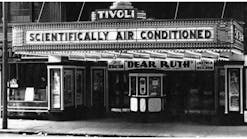Data-Center Maintenance and Efficiency Improved With Air-Inlet Filter Screens
An Internet company committed to running green facilities was facing cooling and maintenance challenges at several of its data centers. Airborne debris, such as cottonwood seed, insects, and leaves, was getting drawn into crossflow cooling towers, resulting in the fouling of fill, sumps, and strainers; reducing overall operational efficiency; and increasing maintenance and energy costs.
"We needed a method of stopping debris at its point of entry without restricting airflow, increasing fan motor torque, or reducing heat rejection," one of the company’s facilities engineers said.
The Solution
The facilities engineer contacted Air Solution Co., manufacturer of air-intake filters (commonly referred to as "cottonwood filter screens") for use on cooling towers and other mechanical systems. The filter screens Air Solution Co. recommended are engineered for use on high-volume/high-velocity air-movement systems with minimal impact on airflow and static pressure. They consist of a specialized non-stick mesh designed for easy cleaning in place and include quick-release fasteners.
Following internal discussions, the Internet company decided to test the screens. The facilities-engineering team devised a controlled test plan calling for key performance measurements twice a day over a two-week period for two identical cooling towers with identical loads. Data points included dry- and wet-bulb temperature, fan-motor kilowatt draw, air velocity, fan-motor revolutions per minute, motor horsepower, motor torque, leaving-water temperature, and return-water temperature. Wind loads also were calculated and factored into the results.
Face-velocity tests were conducted using an anemometer traversing 18 locations across the front and back intake openings.
To establish a baseline, testing first was conducted without the filter screens. Air velocity was found to be highest in the midsection of each opening and very low around the outer edges and corners near where the cross supports attach.
The Findings
Following installation of the filter screens, a 25-percent drop in air velocity in the midsection of the fill was discovered; however, air velocity at the edges and in the corners was found to have increased significantly, providing greater air movement across all regions of the fill and increasing the cooling towers’ heat-rejection capability. In short, the filter screens diffused intake air and increased laminar airflow, which optimized air exposure across the entire surface of the fill; even though air velocity was reduced in the central part of the fill, overall air volume was retained and better utilized.
The increased laminar airflow raised the delta-T and lowered leaving-water temperature at the sump by 1°F. This was seen over the entire spectrum of ambient conditions, with no significant impact on any other key data points.
The team was able to replicate the findings for both cooling towers.
"We estimate that the efficiency gain resulting from the use of the filter screens reduces our fan-motor energy cost by 5 percent," the facilities engineer said, "and with an international network of cooling towers, (that) can amount to huge energy savings."
The facilities engineer added: "Installation of the filters is proving to increase the efficiency of our water-treatment chemicals by reducing the organic load (that) impinges upon present water-treatment levels, while also reducing our maintenance time and effort by over 25 percent."
Factoring in both energy- and maintenance-related savings, the filter screens yielded a payback of 1.5 year, well within the acceptable payback period.
As a result of its findings, the Internet company installed filters on 50 cooling towers and is planning installation at other data centers.
For Design Solutions author guidelines, write to Scott Arnold, executive editor, at [email protected].









